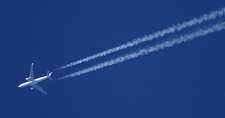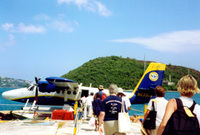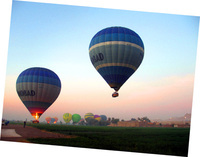by Susan McKee
One advantage of travel writing is the opportunity to travel. Of course, that's one of the disadvantages as well. When you're traveling, you're not where you're going, and you've left where you've been. Transit time is a state of suspended animation. Take getting to Malaysia, for example. It's on the other side of the earth from the American heartland. No matter whether you go east or west, it's still 23 hours of time in the air. I flew from Newark to Kuala Lumpur, so the plane stopped for refueling in Dubai.
Take getting to Malaysia, for example. It's on the other side of the earth from the American heartland. No matter whether you go east or west, it's still 23 hours of time in the air. I flew from Newark to Kuala Lumpur, so the plane stopped for refueling in Dubai.
An hour or so in that international airport terminal is just about enough time to ogle the jewelry and designer clothes for sale and send off a postcard. Then it's back on board, trying to endure the tedium – dropping off to sleep, waking and reading for a bit, then dozing off again.
Stuck in steerage, there's not much to do. Most long distance overseas flights these days have individual television screens – even in coach. But, the movie choices are inane, and how many times can you watch the same episodes of popular TV sitcoms? I find myself tuning into the map charting the plane's progress.
Sometimes that's a mistake.
On a flight from Paris to Cincinnati recently, I watched the plane make a 180° turn as it traversed Ohio. We'd been sent away from the airport in a holding pattern because planes were stacked up ahead of us, trying to land in rainy weather (really bad news when you're already behind schedule).
Then, suddenly, there was a sharp, swift sound, somewhere between a pop and a bang, accompanied by a blinding white light. Zowie! We'd been hit by lightening! As the pilot came on the PA to explain that "everything was OK", I watched the map as the plane did another about face. Suddenly we were in the front of the line to land. (I still missed my connecting flight back home.)
Giant airplanes with hundreds of passengers aren't the only method of getting around in the air. In the U.S. Virgin Islands, I took a pontoon plane to get from St. Thomas to St. Croix. In Britain, I boarded a Sikorski helicopter that seated 25 to get from Penzance to the Isles of Scilly. In Taos, I went up in a balloon. Pontoon planes are hybrids: they land and take off from water. Usually the cockpit is tiny – four cramped seats, and when the engine's going, it's very noisy. Both passengers and pilot wear headsets to communicate aloft.
Pontoon planes are hybrids: they land and take off from water. Usually the cockpit is tiny – four cramped seats, and when the engine's going, it's very noisy. Both passengers and pilot wear headsets to communicate aloft.
Sightseeing is especially good from pontoon planes because they fly relatively slowly at such low altitudes. I had a glimpse of the disappearing wetlands along the Gulf Shore of Louisiana from such a plane, and I got a bird's eye view of the brilliant fall foliage around Moosehead Lake in Maine in a similar aircraft.
Helicopters come in all sorts and sizes. The Sikorski I rode in England was huge – built originally for military use and reconditioned to fly regularly scheduled service to the islands off Land's End. The sightseeing helicopter I boarded in Daytona Beach, Fla., seated just four – but the views of the Atlantic coast and the Daytona Motor Speedway were terrific. Hot air balloons are another kind of flight altogether. It's hard to imagine how they were ever considered as an efficient means of transportation, but they're great for a morning or evening excursion. Up high, it's very quiet – except for the occasional roar of the flames let loose to heat the air to keep everything aloft. Of course, direction is somewhat dependent on the wind, but with a good chase crew on the ground, all turns out well.
Hot air balloons are another kind of flight altogether. It's hard to imagine how they were ever considered as an efficient means of transportation, but they're great for a morning or evening excursion. Up high, it's very quiet – except for the occasional roar of the flames let loose to heat the air to keep everything aloft. Of course, direction is somewhat dependent on the wind, but with a good chase crew on the ground, all turns out well.
Over the years, I have learned some coping strategies for long airplane flights. I never carry on board more than a backpack that stuffs under the seat in front of me (I don't want to wrestle with stowing a heavy wheeled case in an overhead bin).
In that backpack, I have my essentials – the things I positively cannot do without when I land, including an extra pair of contact lenses, laptop, digital camera, cellphone and all those chargers and plug adapters.
Because I try to sleep as much as I can on the plane, I don't need many toys in my bag. I always have a book to read, a notebook and pen, and a guidebook for where I'm going. A bottle of water is essential even though cabin crews are much better than they used to be at passing out glasses of liquid between meal services. Snacks are essential – trail mix works best for me. And I don't forget to walk around occasionally and do leg exercises to minimize the chances of circulation problems aloft.
Fortunately, I forget the agonies of travel once I get off the plane. No matter how tedious the flight, how annoying my seatmates, how unappetizing the food or how dehydrating the cabin, I still look forward to my next trip.
Susan McKee, an independent journalist living in Indianapolis, took her first overseas trip in 1989 and hasn't stopped traveling since.
